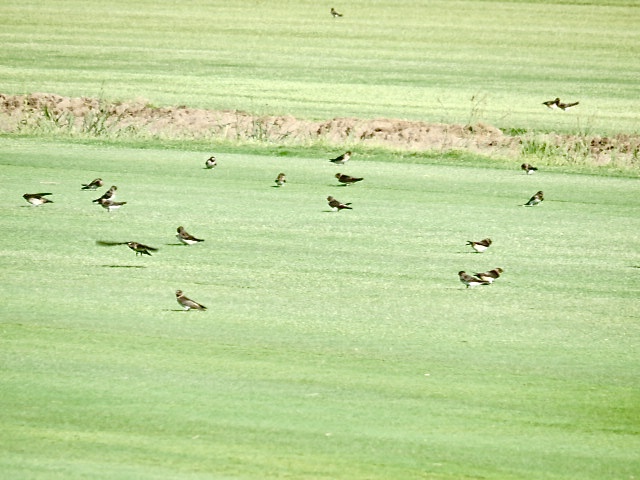Desert birding in our summer months calls for early rising. Usually, I look for shady (using the term loosely) locations, but today, it was a potential beast: Santa Cruz Flats, extending south of Eloy all the way to the Santa Cruz River — a great expanse of open land between the Sawtooth Mountains (west) and Picacho Peak (east).
Who would even think of going out there in mid-July?? Well, Dr. Dave Pearson (ASU) noticed it was an under-birded area and when he discovered 44 TROPICAL KINGBIRDS (or more) in early June, he decided to follow up to discover if there might be fledglings. Lois Lorenz, Kathe Anderson and I joined him on his search.
Did I mention the active monsoon season we’ve been enjoying? Not only does it bring humidity, but this year, lots of thundershowers and extended rainfall. With only a few paved roads through the Flats, the dusty dirt roads might just be a slip and slide mud experience. So, I was thinking the trip might be short-lived.
Stopping first at Arizona City Lake, we began our bird count for the day with thirty-one (31) waterfowl and desert species in half an hour (5:30-6:00 a.m.)
Although we had rain the previous night in the East Valley (Phoenix), the dirt roads within the Flats were dry — but not dusty. Sweet! Not even mud puddles!
SWAINSON’S HAWK (9), both adult and immature, at various locations, often perched in the fields. This immature was really far out in the field but still easier for me to try to photograph than one flying overhead.
We saw more BLUE GROSBEAK on overhead wires than in trees or on the ground.
 |
| BLUE GROSBEAK |
 |
| LUCY'S WARBLER |
In six hours of birding, I need not list each bird we spotted, but the BURROWING OWLs always steal the show.
Our main purpose at the Flats was to determine if the TROPICAL KINGBIRDs had fledged any young. This is a bit farther north than TRKI are usually found and to be in such great numbers is mind-boggling. I'm lucky if I find one or two per year in the southern areas of the state.
What we found was that the TROPICAL KINGBIRD (24 counted) has a nifty song (trill) and a trill of a call, too. When we came upon its trees, one would fly out and over us before circling back down into the leafy pecan trees (on various roads). So, we could surmise that nesting was ongoing. The trill is short, sweet and catchy.
 |
| WESTERN KINGBIRD - with wide white outer tail feathers |
 |
| Series of 3 photos of CLIFF SWALLOWS foraging at the Turf Farms |
Not only was it a day to remember with our 66 species count for the day, (4 separate eBird locations), it begged to be repeated. Will the nesting TROPICAL KINGBIRDS have young by next week? Or, later? Generally, the species migrates out of southern Arizona by the end of July up until September, so there is still time to check out the TRKI again before they take off for the more southern Americas.
 |
| R-L: Dave Pearson, Lois Lorenz and Kathe Anderson |
* * *






Very daring!!! I've done this trek only once in the summer and it was....um.....warm:) And that's to put it mildly:)
ReplyDelete